
|
BLOWING HOT AND COLD
Anti-cyclone anti-climax.
|
WARNING: This
feature is chiefly intended for the benefit and enlightenment of
those readers who have prior experience and knowledge of arcade
Tempest, Tempest 2000 and Tempest X3. |
Sometimes, viewers, things are rare for a
reason.
Alert readers of World Of Stuart will be
aware of both this reporter's
love for the Tempest game series, and of your correspondent's
attempts to secure a Nuon, a videogame console never officially
released in the UK and which was the sole host of the most recent
Tempest iteration, Jeff Minter's Tempest 3000. (Taking over the reins of the
series again after the High Voltage-designed, Interplay-published Tempest
X3 on the Playstation.)
Well, to cut a long story short, your
reporter recently managed to finally secure a Nuon from one of the very
few sellers in Britain, paying a whopping £170 for the privilege (though
to be fair, that included not one but three copies of T3K, along
with a bulky step-down transformer, several S-Video leads and something
called a "Digital Video Stabilizer" which your reporter doesn't even begin
to understand the function of. Other than that, clearly, it stabilizes
digital video in some way). With shaking fingers (never a good thing when
you're handling a scalpel), the huge, extremely well-secured package was
hacked open and convolutedly connected up in just 30 minutes or so, and
with quickening heart your reporter prepared to experience one of the
rarest, potentially greatest games of all time.
Now, you might think that such expectations
would be hard to live up to, and so it proved. Not, however, because a
game couldn't possibly hope to survive so many years as an untouchable
Holy Grail and enigmatic figure of worship. Sadly, Tempest 3000 doesn't
live up to its expectations because it's rubbish.
Take it from this reviewer, chums - in being
unable to lay your hands on a rare Nuon and a copy of this follow-up to
three of the best videogames ever, you're not missing anything. If you
were considering the tortuous process of trying to get one from the USA
(99% of eBay sellers won't ship overseas, so you'll need to find a
friendly contact Stateside, get it sent to them, get them to send it over
here - incurring terrifying total shipping costs - pray Customs don't
decide to levy hefty duties on it, make sure you've got the right sort of
transformer/video cabling, etc), then you should probably keep your money.
Here's why.
This writer's always had a love-hate
relationship with the work of veteran coder Jeff Minter. For every work of
pure genius like Tempest 2000 (the sole purpose for which your reporter
imported an Atari Jaguar from the USA many years ago, for even more money than the Nuon cost)
or the excellent
Gridrunner++, there'll be a diabolical design atrocity like the
abysmal
Defender 2000 or
Photon Storm (a monstrous, mouse-controlled slant on Sinistar published
for the Amiga and ST in the early 90s). Indeed, offhand your correspondent
can't think of a single instance of there being either two good Minter
games or two bad ones released in a row. So in retrospect, we can see T3K
as the inevitable stink-up preceding the splendid GR++, and a prime
example of the work of Bad Jeff.
Tempest 2000 and Tempest X3 (not a Minter
game, but which was heavily based on his T2K), while in many
respects significantly different games, shared one all-important common
factor - a painstaking gameplay balance which ensured that even at their hardest
(and both games' hardest was a
challenging thing indeed) they remained utterly compelling, offering the
player several possible strategies by which the small set of enemies might
be overcome and hence always retaining hope. Both games also ensured, by
clever use of both graphics and sound, that the player was never cheated,
which is of course the other most crucial
factor in giving a game the all-important quality of addiction. Tempest
3000 throws these hard-won lessons out of the window, and in doing so
produces one of the most annoying, unfair and frustrating games it's been
your reviewer's misfortune to play in recent memory.
While it would be distressingly easy to go on for 100 or so paragraphs listing things that are badly wrong with
Tempest 3000 in that regard, it would serve little purpose (given that
this is an old game that almost nobody will ever get to play anyway). So
in order to try to glean some more generally-useful game-design tips out
of the whole ugly business, we'll stick with a handful of highly-specific
and instructive examples, none of which is more telling than the tale of
the Pulsars.
From the very first Tempest game, the Pulsar
has been the most terrifying of all the enemies. An unassuming little
jagged yellow line in form, when the Pulsar stretches out its "arms" to
touch the sides of the channel it's ambling unhurriedly up, it electrifies
the entire lane, instantly destroying the player's Claw should it alight
on the lane for even the briefest instant. In a fast-moving and frantic action game
like Tempest, this is clearly a huge danger (especially when there's more
than one Pulsar on the web, as they all pulse in unison), and accordingly
each iteration of the game has gone out of its way to warn players about
the Pulsars' malevolent presence.
In the original coin-op, for example, the
end bar of any channel containing a Pulsar disappeared, giving a very
clear visual signal to the player amid even the most intensely chaotic
stages. Tempest 2000 and Tempest X3 preferred a mostly aural alarm, with
the Pulsar making a loud sound every time it pulsed, clearly audible above
the game's other sound effects and music, and which enabled the player to
get into the "rhythm" of the pulsing and hence know when to stay still or
leap clear of the web entirely.
In Tempest 3000, though, the Pulsar is a
stealth killer. The only visual sign of its dangerous phase is a slight
brightening of its channel, practically imperceptible at most points in
the game due to the fuzzy nature of the Nuon's graphics, the design of the
webs and the poor framerate the game suffers from much of the time. Worse,
its sonic warning is a feeble little buzz, almost totally inaudible even
if you switch the game's background music down to a whisper, because the
Pulsar's sound level has thoughtlessly been set lower than a bunch of
other - far less important - effects and is hence usually drowned in the
cacophony. The cumulative effect is that on far too many webs, the player
will find himself zapped by a lethal Pulsar that could be neither seen nor
heard.
The game's littered with such cock-ups, both
technical and design in nature. For one thing, the Nuon clearly just isn't
up to the demands being made of its processor - if you leave the game's
default pretty backdrops on during play, the framerate suffers horribly,
and when something extra-dramatic happens - using your all-important
Superzapper, say - it flatlines like a baby mouse someone's just dropped a
lead safe full of bricks on. Combined with the machine's dreadful joypads,
the stuttering framerate makes it absurdly hard to position your Claw
where you want it.
(Ascertaining where it is that you
want it to be isn't all that easy in the first place, either. The fuzzy, effect-smothered webs
are often set far too far in the distance - Tempest 3000 lacks the "zoom-in"
facility of T2K - meaning that your enemies are all too often lost in a
fog anyway, a tiny dot or two at the end of a shifting, flexing, mist-shrouded web,
rendering it impossible to tell either what kind of enemy they are or
exactly which channel they're in.)
Minter's attempt to solve this clearly
obvious problem (and tackle the Pulsar one at the same time) is the
inclusion of the "homing missiles" weapon, a new addition which is capable
of automatically targetting enemies a channel or two either side of the
one you're actually on. For some entirely inexplicable and illogical
reason, though, the homing missiles have absolutely no effect against
Spikes, meaning that at the end of a stage you have to stop shooting, in
order that the auto-firing normal cannon you collected beforehand can deal
with the Spikes.
This is such an anti-intuitive thing to do -
combined with the fact that it's often hard to tell when a level has
actually ended - that you'll end up losing almost as many lives to Spikes
as to real enemies. (Not that you'll notice - dismally, the game lacks any
kind of clear death signal, either visual or aural, so that at the end of
a level you'll often have to wait eight or nine seconds to find out
whether you've cleared the stage or have in fact been impaled on a Spike
and have to start again.)
Tempest 3000 is a game so over-indulgent and
pleased with itself that it simply doesn't care whether the player is
having a good time or not. Having a smug little-girl voice remarking
"Oops... loser!" when you die is one thing when you've been killed due
to your own incompetence, but when you've just lost a third life in a row
to an invisible Pulsar hiding silently down a channel in the far
distance on a web whose design and/or movement means that the "channel" is in fact just a
single one-pixel line on the screen anyway, it's nothing but - and you'll just have to pardon your
reporter's French at this point, because nothing else is adequate for the
purpose - sheer arrogant cuntery.
(Another example of such is the fact that
astoundingly, T3K even resurrects that most hateful and cheaty of
game-wrecking devices, the control-reversing powerup - albeit in the form
of enemies which spin the web around while you're on it, effectively
turning left into right and vice versa. You can shoot them to stop them
doing it, of course, but for the reasons detailed above, your chances of
ever figuring out where they are - or even what they look like - in order
to do so are minimal.)
The change in the character of Pulsars from
a fearsome but honourable adversary to a sneaky, cheating assassin is just
one case in point. Everywhere, by either carelessness or mean spirit, the
careful balance of the earlier games is casually abandoned in favour of
another pointless new addition or special effect. The jump function, for
example, so crucial to both T2K and TX3, is sidelined almost out of
existence in Tempest 3000, replaced by a "hover" function of limited use,
and which is visually all but imperceptible. At a stroke, another layer of
depth in the earlier titles' gameplay is simply wiped out, with nothing to
replace it.
And there are yet more ways in which the
depth of the earlier sequels has been stripped away. The strategic options made possible in
previous games by the chance of starting a new level with the AI Droid
instead of the Particle Laser? Gone. In Tempest 3000, you WILL complete a level in the
exact way Minter wants you to complete it (ie by luck), or you won't complete it at
all.
Relatedly, the varied bonus games which broke up the
hectic pace of the previous versions have been replaced by a single one
here (why?), which appears to largely play itself (your reviewer survived for well
over a minute without touching the controls the first time it appeared),
turning what was a welcome breathing-space, a strategic opportunity and a
refreshingly different challenge into a mere tiresome and unfathomable obstacle to
the next level.
The small, focused set of enemies of the
earlier games has been replaced by a sprawling, undisciplined mess of new
additions. The arcade Tempest had only four kinds of bad guy - Flippers,
Spikers, Fuseballs and Pulsars. Tempest 2000 and Tempest X3 each added
only two or three to the original roster, but Tempest 3000 is burdened
with a whopping 19 different enemies (not including the Tankers
which only carry the other antagonists into battle). The fact that the
game's unfairness ensures you'll never have to encounter most of them is
scant consolation. (Your reviewer can play Tempest X3 in
Trippy Mode, but is at
time of writing struggling to make it past a quarter of T3000's 128
levels, and more importantly struggling to find the desire to do so.)
The Nuon has no save facility, so you'll
need a password to access the higher levels, except the password is
displayed in such tiny, indistinct text (you'll need a team of scientists
to distinguish between a "G" and a "Q", for example,
and that's on your reporter's healthy 29" screen) that you'll probably
copy it down wrongly and keep having to start the game over from scratch.
(Oh, and the passwords are in Welsh, so you probably won't have any chance of figuring them out from context either.) It's a relatively minor problem - though you won't feel that way the first time you lose 10 levels' worth of progress - but it's a telling indication
of just how little thought and care has gone into the production of the
game.
Let's stop now before we all get too
depressed, eh?
Tempest 3000 is a long way from being the
worst game this reporter's ever played, but it'd be hard to bring one to
mind that was a bigger disappointment, or a worse betrayal of its own
heritage. (The only obvious candidate
offering itself right now being the original Gran Turismo which,
implausible as it seems
now, your reviewer was keenly looking forward to
until actually playing it.) It doesn't deserve to carry the same name as
its illustrious predecessors, and it may at last shed some light on the
old mystery of why Minter has historically always seemed to pick consoles
which are obviously doomed to failure to work on. Because the fewer people
who see this sort of half-arsed, ill-thought-out desecration of beauty,
the more likely he is to be commissioned to write more games. This,
however, isn't a game at all. It's a semi-interactive light show with
scoring. What a waste.
Comments? WoS Forum
|
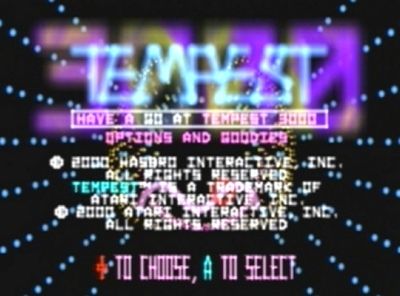
See the word "GO" in that box? Easy to discern from
context, but try reading it reliably when it's part of a password in
fricking Welsh.
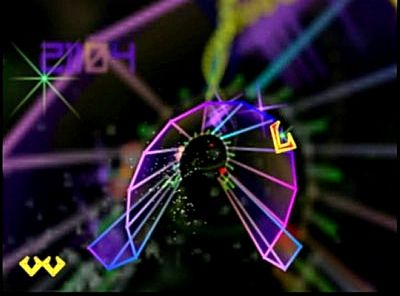
The way some webs flex and "breathe" during play is
one of T3K's few innovations that doesn't get in the way of
the game. Until later.
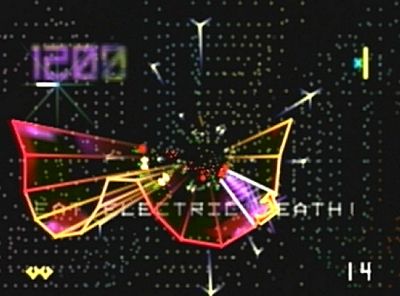
If the framerate during a Superzapper attack with
effects switched on
is as high as 5 fps, your reporter will be surprised.
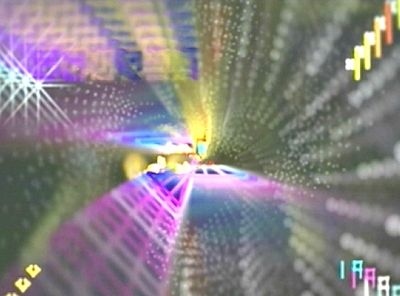
T3K's visual effects would be stunning, if only they
didn't so frequently obscure and interfere with the gameplay.
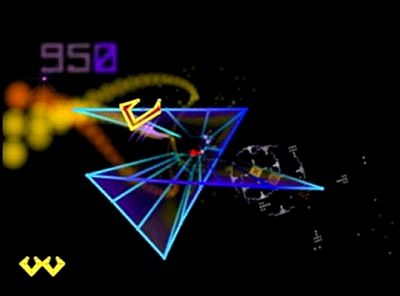
Webs which cross over themselves like this are a
terrible addition, serving only to make an already-confusing game even
more confusing.
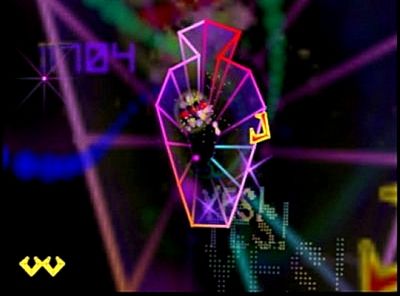
Yeah, let's make the far end of the web actually
disappear into the murk, that'll make things MUCH more fun.
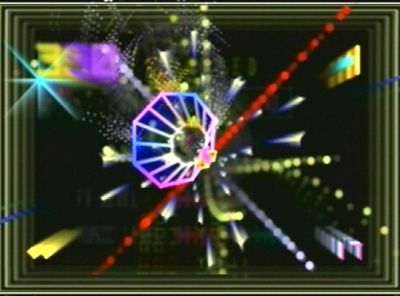
You've probably just died at this point, but it'll be
a few seconds before you can say for sure. Some later webs are actually
this size onscreen.
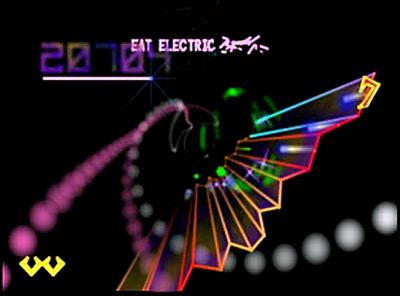
This is one of the clearer levels. Ones further into
the game are often farcically, impossibly complex and convoluted.
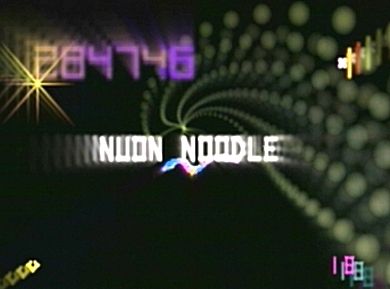
Some of the new webs are pretty, but contain only a
handful of enemies and are over in a matter of seconds.
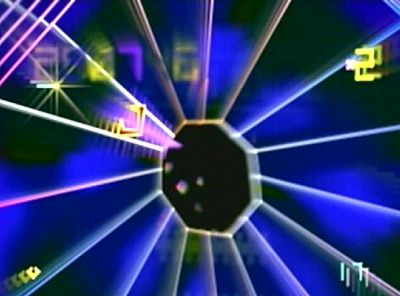
This isn't a wonky screenshot - the game really does
look this fuzzy for much of the time. It's a stylish effect, but
near-unplayable.
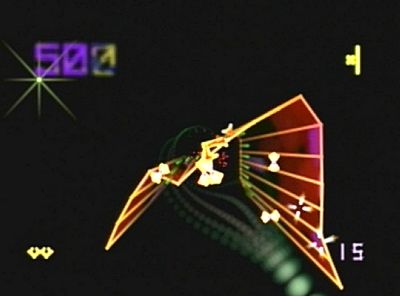
With the background effects switched off the
framerate gets smoother,
but the game still suffers badly from the over-distant viewpoint.
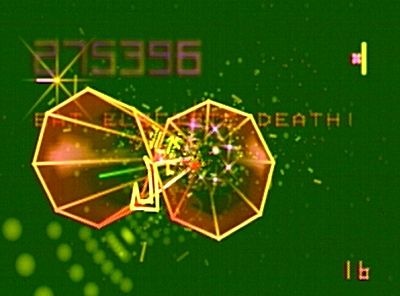
Survival in the
figure-of-eight web is even more founded on sheer random chance than it
was in the original Tempest.
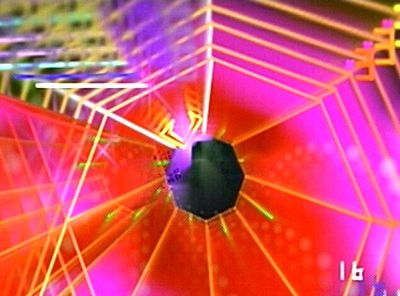
Don't forget to stop firing when you reach those
missile-proof Spikes,
or you'll be scuppered.
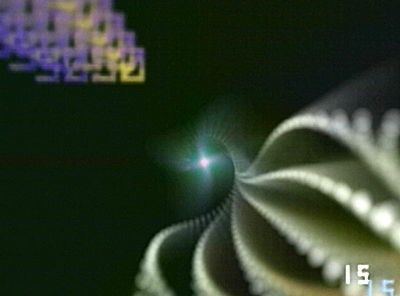
The shining star of Tempest/Tempest 2000/Tempest X3's
brilliance, as viewed from the galactic distance Tempest 3000 falls short of it
by.
|